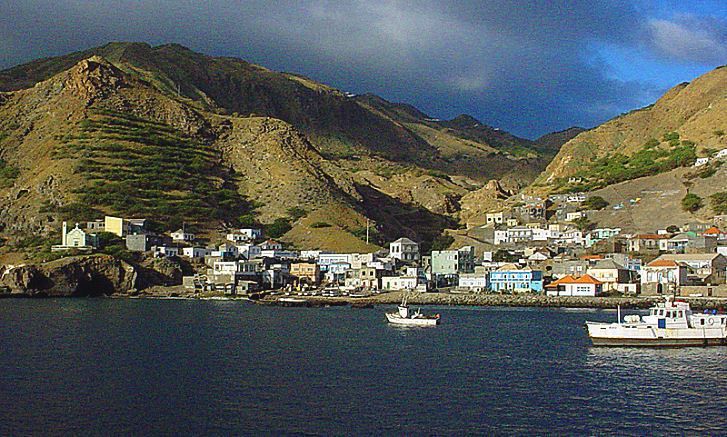Width 16 km (9.9 mi) Area 67 km² | Length 24 km (14.9 mi) Highest elevation 976 m (3,202 ft) Concelhos (Municipalities) Brava Population 6,043 (2010) | |
 | ||
Island groups Sotavento Islands, Cape Verde archipelago | ||
Brava cape verde islands
Brava (Portuguese for “wild”) is an island in Cape Verde. It is the smallest inhabited island, but at the same time the greenest, of Cape Verde, in the Sotavento group. First settled in the 1540s, its population grew after Mount Fogo on neighbouring Fogo erupted in 1675. For more than a century, its main industry was whaling, but the island economy is now primarily agricultural.
Contents
- Brava cape verde islands
- Map of Brava Cape Verde
- History
- Geography
- Climate
- Population
- Economy
- Attractions and amenities
- Politics
- Sporting teams
- Infrastructure
- Notable residents
- References
Map of Brava, Cape Verde
History
Brava was "discovered" in 1462 by Portuguese sailors. The Portuguese founded a settlement here in 1573. The Portuguese operated part of their slave trade in Cidade Velha, using it as a port for exporting slaves to the New World. Sir Francis Drake visited the island in 1579.
In 1680, most inhabitants fled from the nearby larger island of Fogo after its volcano erupted and lava began to flow and devastate that island. They added to the population here. In the 17th and the 18th centuries, pirates raided the bays of the island. Piracy continued until the 19th century, when whaling was common from the ships of Europe and North America.
Emigration began as US whaleships carried people from Brava to the northeastern part of North America, especially along the Eastern Seaboard. Most of the immigrants from Brava settled in Boston and New Bedford, Massachusetts, and Providence, Rhode Island, where there were numerous Cape Verde and Portuguese immigrants. In the 19th century, many of the men continued to work in whaling.
Geography
Practically the whole island is a stratovolcano. It lies in the lee of the enormous Fogo volcano. Volcanic activity on the island has been mainly located along three lines, which all intersect at the crest of ground that forms the highest part of the island. Brava has no documented historical eruptions, but its youthful volcanic morphology and the fact that earthquake swarms still occur indicate the potential for future eruptions.
North of Brava are two small islands with four islets; three of them are west of Ilhéu de Cima. The islands are Ilhéu Grande.
The island's main town is Vila Nova Sintra. The island has elementary and secondary schools, churches, and a square (praça) in honour of the musician Eugénio Tavares.
All of the five villages lie north of the mountaintop, which has four main roads including Furna - Vila Nova Sintra and Fajã de Agua and south to Nossa Senhora do Monte and slightly south of the mountaintop. The two large islands north of Brava are uninhabited. The mountain valleys dominate the south, the east and the west. The north has a few valleys.
Precipitation arrives from the trade wind clouds. The island is covered with a leeward cloud so that evaporation is reduced and the vegetation is more abundant. Key inhabited places include the village of Vila Nova Sintra. The village of Furna has a commercial port.
Climate
Being highly mountainous this island has quite diverse climate. Brava island has moderate tropical climate (As according to Köppen–Geiger climate classification system) along the coast and semi-arid mild tropical climate Bsh with very balanced temperatures year round in the interior. The average annual temperature on the coast is about 23–25 °C (73–77 °F), decreasing to some 17–20 °C (63–68 °F) in the mountains. There can be remarkably cool weather with warmer wet season starting in June and ending in November with colder dry season starting in December and ending in May.
Population
As of 1832, the population was estimated at 8,000.
Economy
The main economy of the island is agricultural, related to irrigation and fishing (the island's main production). Trading and private households depend on income from Cape Verdean residents from North America. Brava never had a lot of tourism. Tourism has slowly increased. The island is unsuitable for beach tourism because the steep shoreline allows few beaches.
Attractions and amenities
Politics
Brava has two seats, in the 2011 election, it had a PAICV and a MpD seat. In the 2016 elections, 40% of the seat was won by the MpD.
Sporting teams
Infrastructure
The airport, inaugurated in 1992, was closed because of the strong winds. The airline service ended in 2004.
Until recently, there was a daily ferry (an ex-fishing boat) connecting Brava and Fogo. Since January 2011, Brava can be reached from Praia (and Fogo) almost exclusively via the passenger/cargo ferry, the Kriola. The Kriola is the first of Cabo Verde Fast Ferry's fleet of inter-island catamarans and connects the Sotavento islands of Santiago, Fogo, and Brava. The Kriola typically leaves Furna, its home port, at 7:30 AM on days of operation and returns between 9:30 and 11 PM, depending on the day. The route is typically BRAVA-FOGO-SANTIAGO-FOGO-BRAVA; at least one day a week it makes a BRAVA-FOGO-BRAVA run. Travel time between Brava and Fogo is approximately 0:40 and approximately 3:30 between Fogo and Santiago (Praia).
The main harbour of Brava is Furna, on the east coast of the island. Buses and taxis are common, especially when the Kriola arrives in port.
On Brava the villages may be reached by "Aluguer" bus. There is no fixed schedule, as the aluguers travel only when there are sufficient passengers. A few taxis are available as well.
